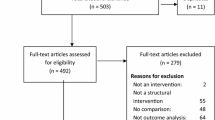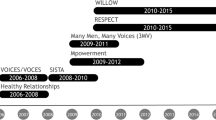This paper presents data from a brief, anonymous, open-ended survey of 50 behavioral research experts in HIV prevention. Responses were received from 31 participants who provided input regarding the primary reasons they believe the rate of the HIV epidemic in the United States has persisted in recent years, and how they believe we can most efficiently decrease the current rate of new HIV infections in the United States. Four clusters of reasons suggested for the persistent rate of new infections: Intervention level reasons, Society level reasons, Person level reasons, and Multiple Risk Factor reasons. Three clusters of strategies suggested for decreasing the current rate: Improved Targeting of HIV Prevention efforts, Larg-Scale Changes to HIV prevention, and Integrating HIV Prevention into more aspects of society. Results are reviewed with the objective of providing a fresh perspective on the potential means for addressing the current HIV epidemic.
Similar content being viewed by others
References
Adams, A. L., Becker, T. M., Lapidus, J. A., Modesitt, S. K., Lehman, J. S., and Loveless, M. O. (2003). HIV infection risk, behaviors, and attitudes about testing—Are perceptions changing? Sexually Transmitted Diseases, 30(10), 764–768.
Amico, K. R., Toro-Alfonso, J., and Fisher, J. D. (in press). An emperical test of the information, motivation, behavioral skills model of antiretroviral therapy adherence. AIDS Care.
Avants, S. K., Margolin, A., Usubiaga, M. H., and Doebrick, C. (2004). Targeting HIV-related outcomes with intravenous drug users maintained on methadone: A randomized clinical trial of a harm reduction group therapy. Journal of Substance Abuse Treatment, 26, 67–78.
Avants, S. K., Warburton, L. A., Hawkins, K. A., and Margolin, A. (2000). Continuation of high risk behavior by HIV-positive drug users: Treatment implications. Journal of Substance Abuse Treatment, 19, 15–22.
Briss, P. A., Brownson, R. C., Fielding, J. E., and Zaza, S. (2004). Developing and using the Guide to Community Preventive Services: Lessons learned about evidence-based public health. Annual Review of Public Health, 25, 281–302.
Centers for Disease Control and Prevention [CDC] (2003). Cases of HIV infection and AIDS in the United States, 2003, HIV/AIDS Surveillance Report, Vol.15. Atlanta, GA: Centers for Disease Control and Prevention.
Centers for Disease Control and Prevention [CDC] (2004). Special! data request. Retrieved August 18, 2004, from http://www.statehealthfacts.kff.org.
Centers for Disease Control and Prevention (2001). HIV prevention strategic plan through 2005. Atlanta, GA: Centers for Disease Control and Prevention.
Colfax, G., Vittinghoff, E., Husnik, M. J., McKirnan, D., Buchbinder, S., Koblin, B., Celum, C., Chesney, M., Huang, Y. J., Mayer, K., Bozeman, S., Judson, F. N., Bryant, K. J., and Coates, T. J. (2004). Substance use and sexual risk: A participant and episode-level analysis among a cohort of men who have sex with men. American Journal of Epidemiology, 159(10), 1002–1012.
Copenhaver, M., Avants, S. K., Margolin, A., and Warburton, L. A. (2003). Intervening effectively with drug abusers infected with HIV: Taking into account the potential for cognitive impairment. Journal of Psychoactive Drugs, 35(2), 209–218.
Erbelding, E. J., Stanton, D., Quinn, T. C., and Rompalo, A. (2000). Behavioral and biologic evidence of persistent high-risk behavior in an HIV primary care population. AIDS, 14(3), 297–301.
Fisher, J. D., Fisher, W. A., Amico, R., and Harman, J. J. (in press). An information-motivation-behavioral skills model of adherence to antiretroviral therapy. Health Psychology.
Gareau, S. E. (2004). The development of guidelines for implementing information technology to promote food security. Agriculture and Human Values, 21(4), 273–285.
Joint United Nations Programme on HIV/AIDS (2004). Q&A II: Basic facts about the AIDS epidemic and its impact, UNAIDS questions and answers. Retrieved August 16, 2004, from http://www.unaids.org.
Kaid, L. L., and Wadsworth, A. J. (1989). Content analysis. In P. Emmert and L. Barker (Eds.), Measurement of communication behavior (pp. 197–217). New York: Longman.
Kalichman, S. C. (2000). HIV transmission risk behaviors of men and women living with HIV-AIDS: Prevalence, predictors, and emerging clinical interventions. Clinical Psychology-Science and Practice, 7(1), 32–47.
Kassarjian, H. (1977). Content Analysis in Consumer Research. Journal of Consumer Research, 4(June), 8–18.
Koblin, B. A., Chesney, M. A., Husnik, M. J., Bozeman, S., Celum, C. L., Buchbinder, S., Mayer, K., McKirnan, D., Judson, F. N., Huang, Y. J., and Coates, T. J. (2003). High-risk behaviors among men who have sex with men in 6 US cities: Baseline data from the EXPLORE study. American Journal of Public Health, 93(6), 926–932.
Margolin, A., Avants, S. K., Warburton, L. A., Hawkins, K. A., and Shi, J. (2003). A randomized clinical trial of a manual-guided risk reduction intervention for HIV-positive injection drug users. Health Psychology, 22(2), 223–228.
Marks, G., Burris, S., and Peterman, T. A. (1999). Reducing sexual transmission of HIV from those who know they are infected: The need for personal and collective responsibility. AIDS, 13(3), 297–306.
National Institutes of Health [NIH] (1997). Interventions to Prevent HIV-Risk Behaviors. NIH Consensus Statement 11–13; 15(2):1–41. Bethesda, MD: National Institutes of Health, U.S. Department of Health and Human Services.
National Institutes of Health [NIH] (2004). Fiscal year 2005 plan for HIV-related research. NIAID: National Institute of Allergy and Infectious Diseases, National Institutes of Health, U.S. Department of Health and Human Services.
Semple, S. J., Patterson, T. L., and Grant, I. (2004). The context of sexual risk behavior among heterosexual methamphetamine users. Addictive Behaviors, 29(4), 807–810.
Truman, B. I., Smith-Akin, C., Hinman, A. R., Gebbie, K. M., Brownson, R., Novick, L. F., Lawrence, R. S., Pappaioanou, M., Fielding, J., Evans, C. A., Guerra, F. A., Vogel-Taylor, M., Mahan, C. S., Fullilove, M., and Zaza, S. (2000). Developing the guide to community preventive services—overview and rationale. American Journal of Preventive Medicine, 18(1), 18–26.
Trussell, N., and Lavrakas, P. J. (2004). The influence of incremental increases in token cash incentives on mail survey response. Public Opinion Quarterly, 68(3), 349–367.
Tworoger, S., Yutaka, Y., Ulrich, C. M., Nakamura, H., LaCroix, K., Johnston, R., and McTiernan (2002). Mailing strategies and recruitment into an intervention trial of exercise effect on breast cancer biomarkers. Cancer Epidemiology Biomarkers and Prevention, 11, 73–77.
Valdiserri, R. (2003, December). Symposium conducted at the Center for Interdisciplinary Research on AIDS and the Institution for Social and Policy Studies (CIRA). In M. H. Merson (Chair), CDC's Initiative "Advancing HIV Prevention:" Implications for Policy, Research, and Practice, New Haven, CT.
Zajac, B. M. (2004). Performance measurement of disease management programs–Examination of recent guidelines. Disease Management and Health Outcomes, 12(4), 211–220.
ACKNOWLEDGMENTS
This paper was supported by the following grants: 1 K23 DA17015-01A1 (Michael Copehaver, PI) from the National Institute on Drug Abuse (NIDA), and 1R01 MH066684-01A1 (Jeffrey Fisher, PI) and RO1 MH59473 (Jeffrey Fisher, PI) from the National Institute of Mental Health (NIMH).
Author information
Authors and Affiliations
Corresponding author
Additional information
Electronic supplementary material
Electronic supplementary material is available for this article at http://dx.doi.org/10.1007/s10461-005-9034-x and accessible for authorised users.
Electronic suppleenmtary material
Rights and permissions
About this article
Cite this article
Copenhaver, M.M., Fisher, J.D. Experts Outline Ways to Decrease the Decade-Long Yearly Rate of 40,000 New HIV Infections in the US. AIDS Behav 10, 105–114 (2006). https://doi.org/10.1007/s10461-005-9034-x
Published:
Issue Date:
DOI: https://doi.org/10.1007/s10461-005-9034-x




